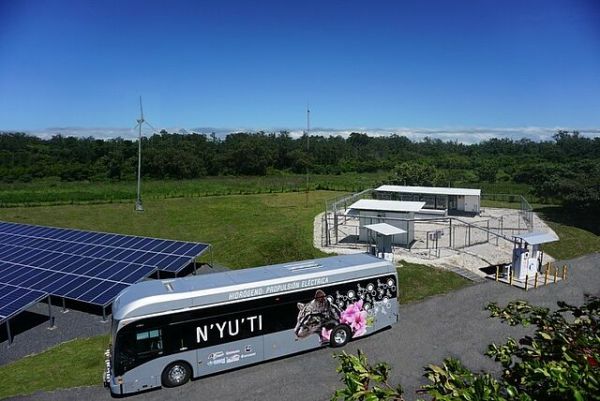A green future with hydrogen: a sustainable alternative for transport and industry in Costa Rica

Disclaimer: This article was written by Constanza Meneses (GIZ) with the support of Natalia Romero (GIZ) and has been slightly adapted for the NAMA Facility website with permission from the “Costa Rica – Green Hydrogen” NAMA Support Project (NSP).
Costa Rica is a pioneer in green hydrogen issues and continues to make successful progress towards its goal of decarbonisation by 2050. After participating in the Ambition Initiative Call of the NAMA Facility, the NSP “Costa Rica – Green Hydrogen” was selected to receive funds for green hydrogen for a decarbonised economy in the country.
The project foresees an investment of EUR 25 million for the production and application of innovative technologies that have the purpose of reducing emissions from greenhouse gases (GHGs) and generating a positive impact in both social and economic areas, as well as for climate protection.
Ad Astra Rocket Company, a company originally dedicated to the development of plasma engines for space aircraft, has a branch in the province of Guanacaste where green hydrogen has been produced and researched since 2011. The company runs a complete value chain of green hydrogen, from its production with renewables and compression, to its storage and application. While the company aims for hydrogen to be used for cars and buses, it is limited to the commercial use of a few vehicles.
From this premise, the NSP proposes the following idea: to replicate what exists on a larger scale, using the knowledge and experience acquired by Ad Astra Rocket Company, which has been enhanced through the Hydrogen Alliance, a Costa Rican think tank that brings together companies primarily from the country’s private sector.
The NSP aims to promote the development of green hydrogen, that is, to use the country’s green electricity (99.9% from renewables in 2021) to produce green H2 and to use in various sectors of the economy. The project will begin with domestic applications such as transport, primarily heavy trucks, but with the purpose of eventually implementing hydrogen and its derivatives in railways, maritime transport and aviation. In addition, applications in the metallurgy industry are planned, as well as other sectors in the medium term, such as cement, glass and agriculture.
“Besides promoting H2 application in transport, we want to see where hydrogen is already being used in the industrial sector and highlight the importance of its origin, since it is mostly not green H2 and that entails two problems: the GHG emissions in other countries are perpetuated and the dependence on imports continues” Claus Kruse (GIZ), interim director of Costa Rica – Green Hydrogen
The project is based on a financing model through national and international banks with credits and subsidies, as well as a package of complementary technical assistance measures to ensure that those who want to produce green hydrogen, buy fuel cell electric vehicle (FCEV) trucks, or adapt their industry to the use of green hydrogen can do so by accessing funds and become early movers.
In the coming months, the NSP will work on the so-called “Detailed Preparation Phase” (DPP), which involves the formulation of the complete project. Thus, although the project concept has been deemed suitable to the goals of the NAMA Facility, a detailed preparation is now expected with a deadline of 10 months to present the project and its implementation strategy to the Donors of the NAMA Facility. Upon final approval, the implementation of the project is foreseen to start by mid/end-2023.
Costa Rica: an oasis of renewable energy
In this context, Costa Rica has a great comparative advantage, since 99.9% of its electricity comes from renewable sources. This is an exceptional case, as it greatly facilitates the current production of hydrogen to be green. Thus, the country is ahead of the others that still have to boost the production of renewable energies to achieve a truly green hydrogen.
However, even though the country’s electricity comes mostly from renewable sources, total GHG emissions are still estimated at 10.9 million tCO2 in 2019. The transport sector with medium and heavy trucks, buses and an ever-increasing number of private vehicles is responsible for more than 50% of total emissions. This places even greater importance on the decarbonisation of the transport sector to achieve the country’s objectives.
Overall, Costa Rica has optimal conditions to decarbonise its economy. The main goals of its national policies and its Hydrogen Roadmap is to clearly define the intention for green hydrogen as a leading fuel source for energy and transport sectors. It is considered as an energy vector with the potential to help the decarbonisation of areas that will otherwise continue to depend on fossil fuels or grey hydrogen.
Currently, the country is working on the development of a National Hydrogen Strategy, which will seek to establish strategic lines for the development of a green hydrogen market nationally and internationally in order to attract private investment and generate business opportunities. This strategy will include indicators and targets, as well as the definition of strategic interventions and will be accompanied by an action plan with the identification of critical activities and risk analysis. Thus, if Costa Rican policies continue to move forward with this approach, as they have done in the past, they could lead to the beginning of an energy transition with immense impact.
Learn more about Costa Rica – Green Hydrogen.
The NAMA Facility is a joint initiative of the German Federal Ministry for the Environment, Nature Conservation and Nuclear Safety (BMU), UK’s Department for Business, Energy and Industrial Strategy (BEIS), the Danish Ministry of Climate, Energy and Utilities (KEFM), the Danish Ministry of Foreign Affairs (MFA), the European Union and the Children’s Investment Fund Foundation (CIFF).
